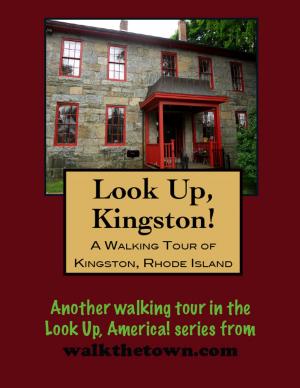| Author: | Doug Gelbert | ISBN: | 9781458033390 |
| Publisher: | Doug Gelbert | Publication: | March 3, 2011 |
| Imprint: | Smashwords Edition | Language: | English |
| Author: | Doug Gelbert |
| ISBN: | 9781458033390 |
| Publisher: | Doug Gelbert |
| Publication: | March 3, 2011 |
| Imprint: | Smashwords Edition |
| Language: | English |
There is no better way to see America than on foot. And there is no better way to appreciate what you are looking at than with a walking tour. This walking tour of Hoboken, New Jersey is ready to explore when you are. Each walking tour describes historical, architectural landmarks, cultural sites and ecclesiastic touchstones and provides step-by-step directions.
Every tour also includes a quick primer on identifying architectural styles seen on American streets.
The Dutch rowed across the Hudson River from New Amsterdam and established the first community here in 1642. It is remembered for America’s first brewery that was set up in those last days before English rule but not much else. It was mostly just tidal marshes and swampland.
It was the estate of an Englishman named William Bayard who originally was with the revolutionary cause but reverted back to the Loyalists after New York fell in 1776. His property was seized by the new Americans after the Revolutionary War and put up for auction. Bidding was not spirited but it cost Colonel John Stevens 18,360 pounds sterling for 564 acres. Stevens set about developing the waterfront for what he saw as a resort for New Yorkers. The rich and famous did make their way here and eventually America’s first yacht club was founded in Hoboken.
But real estate was not his main game. Stevens would shortly be developing one of the world’s first steamboats and the first to sail on the open ocean and serve as a ferry on the Hudson River. In 1825 he built an early steam locomotive. Before his death in 1838, Stevens founded The Hoboken Land Improvement Company, which during the mid- and late-19th century was managed by his heirs and laid out a regular system of streets, blocks and lots, and constructed housing.
Soon Hoboken morphed from a community of beer gardens and nature walks to a manufacturing center and a busy port. The dock workers gave Hoboken a legacy of grit and toughness, immortalized in the Hollywood classic, On the Waterfront, that spent a month filming on location here. It was said that some blocks contained 50 saloons.
But Hoboken’s identity was about to make another 180-degree turn. Ferry service stopped in 1966. The big manufacturers of tea and coffee and slide rulers all left. Everyone of them. Developers moved in with deep pockets and discovered Hoboken’s wealth of old buildings, none too high, four-and five-stories at the tallest. There were brownstones and Victorian public buildings and old piers and factories waiting to be torn down or re-developed. Hoboken was at the forefront of gentrification.
The result is that our walking tour of the town, only a dense one mile square, will be mostly a residential walk, although for the most part it didn’t start out that way...
There is no better way to see America than on foot. And there is no better way to appreciate what you are looking at than with a walking tour. This walking tour of Hoboken, New Jersey is ready to explore when you are. Each walking tour describes historical, architectural landmarks, cultural sites and ecclesiastic touchstones and provides step-by-step directions.
Every tour also includes a quick primer on identifying architectural styles seen on American streets.
The Dutch rowed across the Hudson River from New Amsterdam and established the first community here in 1642. It is remembered for America’s first brewery that was set up in those last days before English rule but not much else. It was mostly just tidal marshes and swampland.
It was the estate of an Englishman named William Bayard who originally was with the revolutionary cause but reverted back to the Loyalists after New York fell in 1776. His property was seized by the new Americans after the Revolutionary War and put up for auction. Bidding was not spirited but it cost Colonel John Stevens 18,360 pounds sterling for 564 acres. Stevens set about developing the waterfront for what he saw as a resort for New Yorkers. The rich and famous did make their way here and eventually America’s first yacht club was founded in Hoboken.
But real estate was not his main game. Stevens would shortly be developing one of the world’s first steamboats and the first to sail on the open ocean and serve as a ferry on the Hudson River. In 1825 he built an early steam locomotive. Before his death in 1838, Stevens founded The Hoboken Land Improvement Company, which during the mid- and late-19th century was managed by his heirs and laid out a regular system of streets, blocks and lots, and constructed housing.
Soon Hoboken morphed from a community of beer gardens and nature walks to a manufacturing center and a busy port. The dock workers gave Hoboken a legacy of grit and toughness, immortalized in the Hollywood classic, On the Waterfront, that spent a month filming on location here. It was said that some blocks contained 50 saloons.
But Hoboken’s identity was about to make another 180-degree turn. Ferry service stopped in 1966. The big manufacturers of tea and coffee and slide rulers all left. Everyone of them. Developers moved in with deep pockets and discovered Hoboken’s wealth of old buildings, none too high, four-and five-stories at the tallest. There were brownstones and Victorian public buildings and old piers and factories waiting to be torn down or re-developed. Hoboken was at the forefront of gentrification.
The result is that our walking tour of the town, only a dense one mile square, will be mostly a residential walk, although for the most part it didn’t start out that way...















